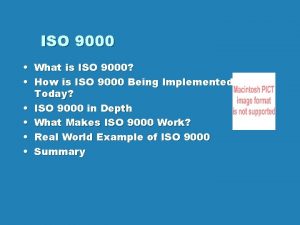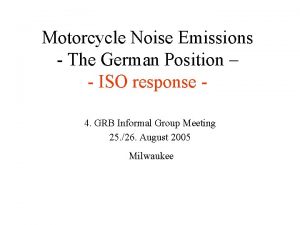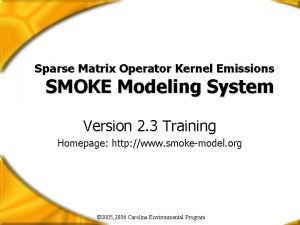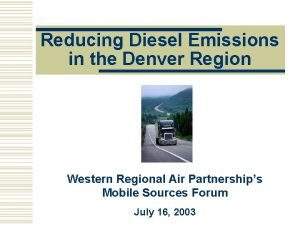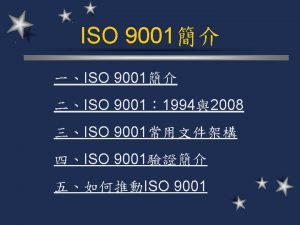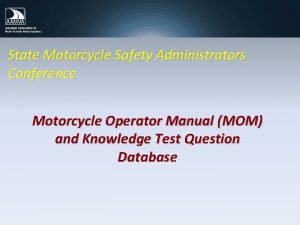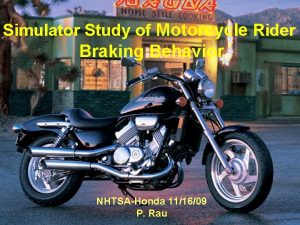Motorcycle Noise Emissions The German Position ISO response








- Slides: 8

Motorcycle Noise Emissions - The German Position – - ISO response 4. GRB Informal Group Meeting 25. /26. August 2005 Milwaukee

At the 40 th GRB meeting in September 20054 an Informal Group has been established to revise ECE-R 41. The target was to prepare a draft amendment to the existing regulation on the base of a driveby procedure developed by ISO. During the last meetings it became obvious that there are different national assessments on what the target of the revision of ECE-R 41 should be. With this position paper the German delegation wants to point out again what the main German concerns regarding the proposed test procedure by ISO are and which issues therefore should be covered by the ongoing revision of ECE-R 41.

Main concerns regarding the method proposed by ISO (1) • • The measurement method mostly reflects urban driving conditions. Conditions with higher engine speeds, accelerations and corresponding high noise emissions, which occur at transitions between urban and rural areas and therefore affect peoples wellbeing and health, are not covered adequately. ISO‘s aim has been to develop a test procedure that replicates typical motorcycle operating conditions for situations where motorcycles are in closest proximity to the greater part of the population and during most of the day. The now fully recalculated WMTC part 1 -based n/S curve (16 -R 41 WG-05 -ann 2) has shifted normalized engine speeds upwards and has in turn resulted in a higher awot curve that has been incorporated in the latest revision of the ISO procedure. The relatively small difference in normalized engine speeds between WMTC part 1 (urban) and part 2 (rural) in-use data was shown in earlier IMMA material (10 R 41 WG-05 -ann 2; slide 3). Estimation of noise exposure in the rural environment (noise level, time duration, population affected, type of source) was never provided. The proposed method by ISO is not reproducible within the scope of roadside inspections. The aim of ISO has always been to deliver a test method for certification use. The D delegation agreed to prepare a proposal for additional test that could be used for both roadside enforcement and ASEP use.

Main concerns regarding the method proposed by ISO (2) • • • The proposal does not contain construction requirements to prevent tampering. This is outside the scope of ISO. Existing regulatory anti-tampering provisions should be reviewed for suitability. Measures to prevent test-cycle-detection and the use of defeat devices are not contained in the proposal. This is outside the scope of ISO but the existence of a prescribed acceleration rate that is linked to the motorcycle’s intrinsic performance potential makes the ISO test procedure more robust than the current ECE R-41. There are no indications for non-linear noise output in earlier IMMA material (07 -R 41 WG-05 -ann 4; slide 4). Wording based on that being considered for ECE R-51 is introduced in the draft revision of ECE R-41. The D delegation agreed to prepare a proposal for additional test that could be used for both roadside enforcement and ASEP use. Low-powered and high-powered motorcycles are misbalanced within the proposed test method. The method developed by ISO allows the simulation of partial throttle acceleration motorcycle noise on the basis of the correlations between engine speed, power to mass ratio, in-use acceleration and acceleration potential.

Main Issues to be covered by a revision of ECE-R 41 (1) • • A measurement method for type approval of motorcycles also has to cover driving conditions that are representative for transitions between urban and rural areas. ECE-R 41 has to be revised in a way that the type approval procedure can be reproduced within the scope of roadside inspections. Therefore a simple measurement method is needed.

Main Issues to be covered by a revision of ECE-R 41 (2) • • • Construction requirements for example according to chapter 7 of 97/24/EG in order to prevent tampering have to be implemented in ECE-R 41. Implementation of measures to prevent test-cycledetection and the use of defeat devices during type approval. The technical differences between low-powered and high -powered motorcycles need to be reflected within the type approval test procedure.

Open question ISO has not yet explained to the satisfaction of the German delegation why there is a need for a constant speed test for the type approval of motorcycles. The following was explained in previous meetings: - accelerations in real traffic are predominantly partial load accelerations with the degree of partial load and acceleration level depending on the power to mass ratio - because noise measurements with partial throttle acceleration have a poor repeatability, they are approximated by a combination of a WOT acceleration and a constant speed test Earlier material by IMMA (07 -R 41 WG-05 -ann 1; slides 6 and 7) proves the ability of the ISO test procedure to accurately simulate partial throttle noise emissions with correct focus on the noise contribution from individual components.

Conclusions Germany sees the need for a general discussion within the Informal group about the main targets of the revision of ECE -R 41 and about possibilities how to take into account the different national concerns and interests. Also the important question about the need of a constant speed test for the type approval procedure for motorcycles has to be answered by ISO.
